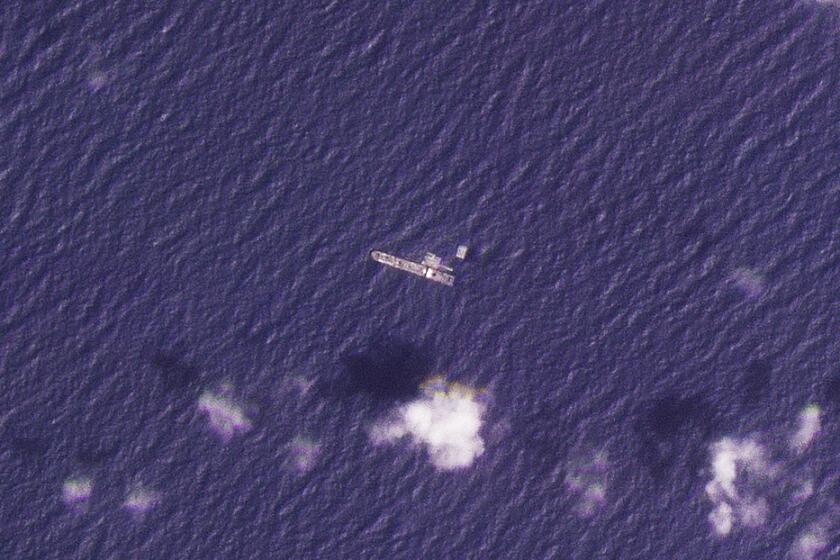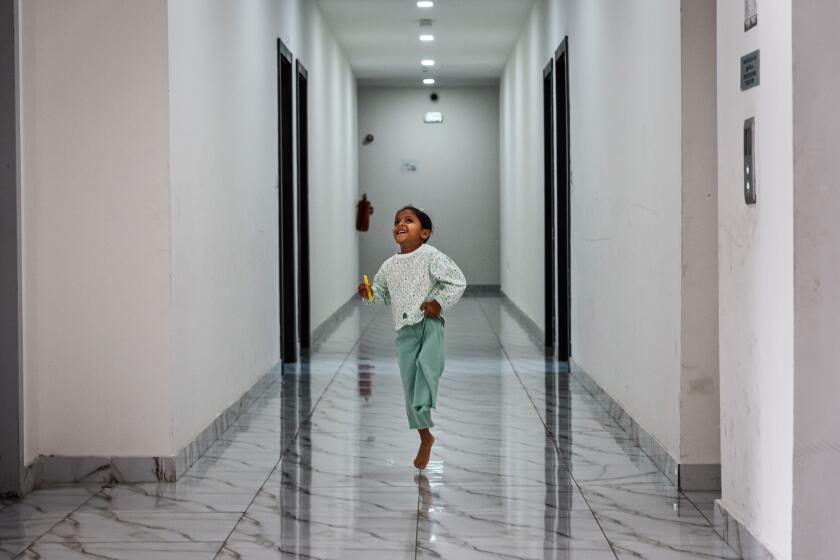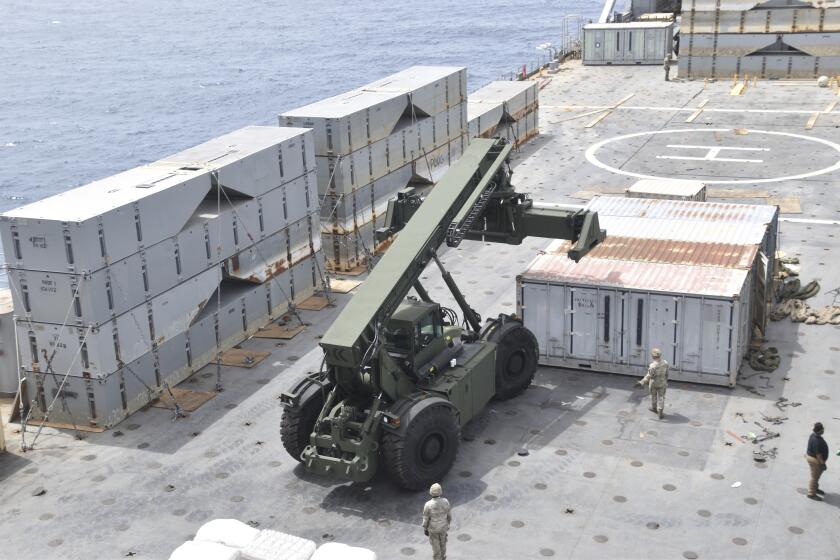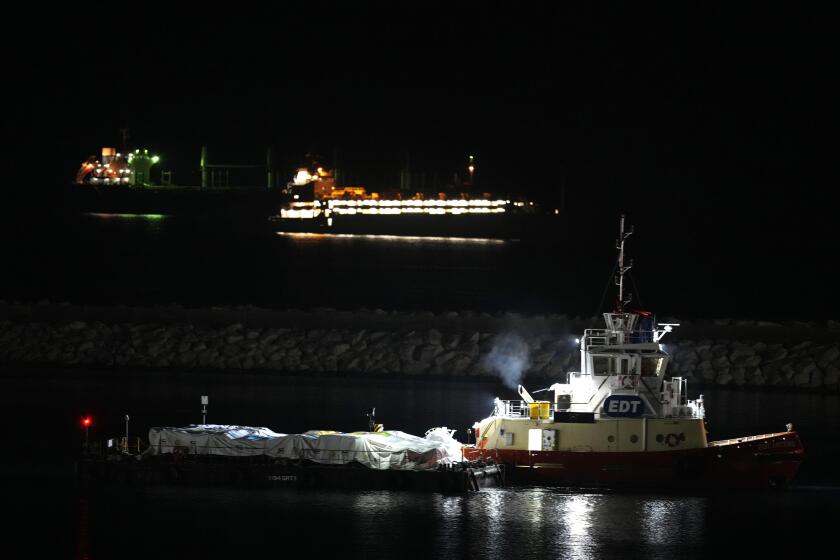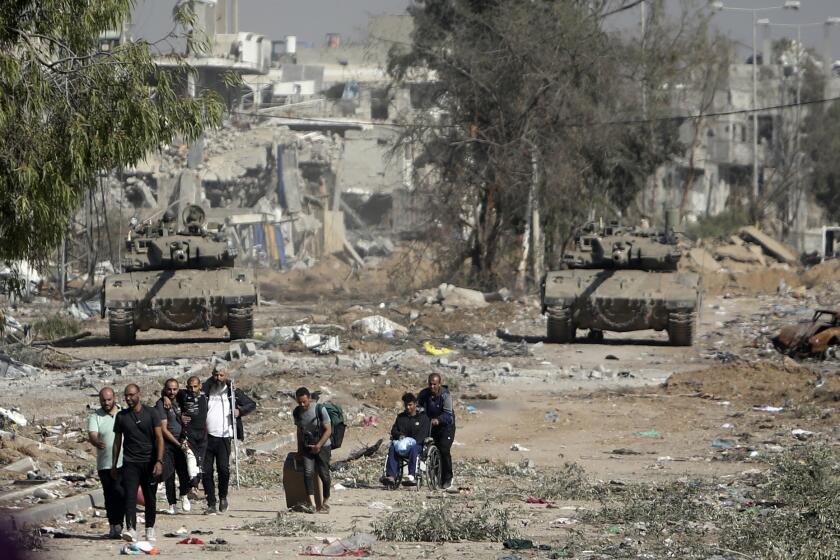U.S. military says Gaza floating pier is complete, aid to Palestinians to flow soon
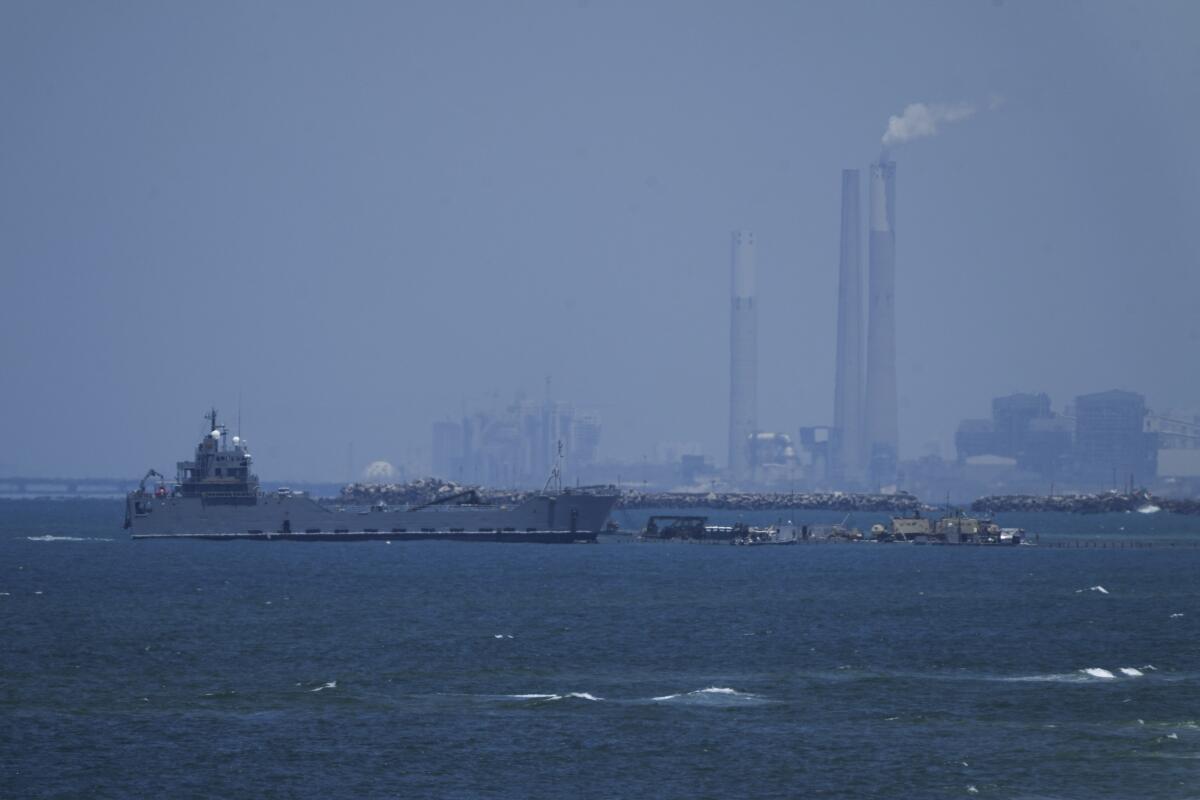
- Share via
WASHINGTON — The U.S. military finished installing a floating pier off the Gaza Strip on Thursday, with officials poised to begin ferrying badly needed humanitarian aid into the enclave besieged by more than seven months of intense Israeli attacks.
The final, overnight construction sets up a complicated delivery process more than two months after President Biden ordered it to help Palestinians facing starvation as Israeli restrictions on border crossings and heavy fighting prevent food and other supplies from making it into Gaza.
Fraught with logistical, weather and security challenges, the pier project — expected to cost $320 million — is designed to bolster the amount of aid getting into the Gaza Strip, but it is not considered a substitute for far cheaper and more efficient land-based deliveries that aid agencies say are much more sustainable.
The boatloads of aid will be deposited at a port facility built by the Israelis just southwest of Gaza City and then distributed by aid groups.
A U.S. Navy ship and several Army vessels involved in an effort to bring more aid into the Gaza Strip are building out a floating platform for the operation.
U.S. officials said Thursday as much as 500 tons of food will begin arriving on the Gaza shore within days and that the United States has closely coordinated with Israel on how to protect the ships and personnel working on the beach.
But there are still questions on how aid groups will safely operate in Gaza to distribute food to those who need it most, said SonaliKorde, assistant to the administrator of the U.S. Agency for International Development’s Bureau for Humanitarian Assistance, which is helping with logistics.
“There is a very insecure operating environment,” and aid groups are still struggling to get clearance for their planned movements in Gaza, Korde said. Those talks with the Israeli military “need to get to a place where humanitarian aid workers feel safe and secure and able to operate safely. And I don’t think we’re there yet.”
Fighting between Israeli troops and Palestinian militants on the outskirts of Rafah has displaced some 700,000 people, United Nations officials say. Israel recently seized the key Rafah border crossing in its push against Hamas.
More than 1.4 million Palestinians — most of Gaza’s population — have been sheltering in Rafah, most after fleeing Israel’s offensives elsewhere.
Pentagon officials said the fighting in Gaza wasn’t threatening the new shoreline aid distribution area, but they have made it clear that security conditions will be monitored closely and could prompt a shutdown of the maritime route, even just temporarily.
Already, the site has been targeted by mortar fire during its construction, and Hamas has threatened to target any foreign forces who “occupy” the Gaza Strip.
.
Israel-Hamas war: In Qatar’s capital, a compound housing Palestinian medical evacuees from Gaza is a living catalog of what war does to the human body.
The “protection of U.S. forces participating is a top priority. And as such, in the last several weeks, the United States and Israel have developed an integrated security plan to protect all the personnel,” said Navy Vice Adm. Brad Cooper, a deputy commander at the U.S. military’s Central Command. “We are confident in the ability of this security arrangement to protect those involved.”
Israel-Hamas war: The U.S. expects to start delivering aid via a new sea route to Gaza this month, prioritizing food for starving children.
U.S. troops anchored the pier Thursday morning, Central Command said, stressing that none of its forces entered the Gaza Strip and would not during the pier’s operations. It said trucks with aid would move ashore in the coming days and “the United Nations will receive the aid and coordinate its distribution into Gaza.”
The U.N. World Food Program will be handling the aid, officials said.
Israeli forces will be in charge of security on the shore, but there are two U.S. Navy warships near the area in the eastern Mediterranean Sea, the USS Arleigh Burke and the USS Paul Ignatius. Both ships are destroyers equipped with a wide range of weapons and capabilities to protect American troops offshore and allies on the beach.
The British logistics ship RFA Cardigan Bay will also provide support, Cooper said.
Israeli military spokesman Lt. Col. Nadav Shoshani confirmed that the pier had been attached and that Israeli engineering units had flattened ground around the area and surfaced roads for trucks.
With too little humanitarian aid reaching Gaza over land, the United States is leading an effort to build a floating pier that will allow deliveries by sea.
“We have been working for months on full cooperation with [the U.S. military] on this project, facilitating it, supporting it in any way possible,” Shoshani said. “It’s a top priority in our operation.”
The U.N., U.S. and international aid groups say Israel is allowing only a fraction of the normal prewar deliveries of food and other supplies into Gaza since Hamas’ attack on Israel launched the war in October.
Aid agencies say they are running out of food in southern Gaza and fuel is dwindling, while the U.S. Agency for International Development, known as USAID, and the World Food Program say famine has taken hold in Gaza’s north.
Israel blames the U.N. for delays in distributing goods entering Gaza. The U.N. says fighting, Israeli fire and chaotic security conditions have hindered delivery.
Under pressure from the United States, Israel has in recent weeks opened a pair of crossings to deliver aid into hard-hit northern Gaza and said that a series of Hamas attacks on the main crossing, Kerem Shalom, disrupted the flow of goods.
The first cargo ship loaded with 475 pallets of food left Cyprus last week to rendezvous with a U.S. military ship, the Roy P. Benavidez, off the Gaza coast.
Egypt issued its strongest objection to the Rafah offensive, saying it will join South Africa’s case at the International Court alleging Israel is committing genocide.
The installation of the pier and a causeway, which is now anchored to the beach, was delayed for nearly two weeks because of bad weather. The sea conditions made it too dangerous for U.S. and Israeli troops to secure the causeway to the shore, U.S. officials said.
Military leaders have said the deliveries of aid will begin slowly to ensure the system works.
They will start with about 90 truckloads of aid a day through the sea route, and that number will grow to about 150 a day. But aid agencies say that isn’t enough to avert impending famine in Gaza and must be just one part of a broader Israeli effort to open land corridors.
Because land crossings could bring in all the needed aid if Israeli officials allowed, the U.S.-built pier-and-sea route “is a solution for a problem that doesn’t exist,” said Scott Paul, an associate director of the Oxfam humanitarian organization.
When Israel declared war against Hamas, it stood unified at home. Now it is isolated amid global outrage over the rising death toll in the Gaza Strip.
Under the new sea route, humanitarian aid is dropped off in Cyprus, where it will undergo inspection and security checks at the Larnaca port. It is then loaded onto ships — mainly commercial vessels — and taken to the floating pier several miles off Gaza.
There, the pallets are transferred onto trucks, driven onto U.S. Army boats and then shuttled to the floating causeway.
The trucks, driven by personnel from another country, will go down the causeway into a secure area on land, where they will drop off the aid and return to the boats.
Baldor writes for the Associated Press. AP writers Jon Gambrell in Dubai and Julia Frankel in Tel Aviv contributed to this report.
More to Read
Sign up for Essential California
The most important California stories and recommendations in your inbox every morning.
You may occasionally receive promotional content from the Los Angeles Times.
